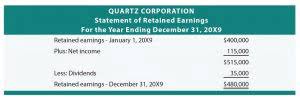
Retained earnings refer to the portion of a company’s net income or profits that it retains and reinvests in the business instead of paying out as dividends to shareholders. It’s an equity account in the balance sheet, and equity is the difference between assets (valuables) and liabilities (debts). The https://www.bookstime.com/ amount of a corporation’s retained earnings is reported as a separate line within the stockholders’ equity section of the balance sheet. However, the past earnings that have not been distributed as dividends to the stockholders will likely be reinvested in additional income-producing assets or used to reduce the corporation’s liabilities.
What Is the Difference Between Retained Earnings and Revenue?

The income statement calculates net income, which is the balance you have after subtracting additional expenses from the gross profit. Retained earnings for a single period can reveal trends in the company’s reinvestment, but they don’t tell you how those funds are used, or what the return on investment is. Looking at retained earnings can be useful, but they’re more valuable when observed over a longer period of time. The normal balance in a profitable corporation’s Retained Earnings account is a credit balance. This is logical since the revenue accounts have credit balances and expense accounts have debit balances. If the balance in the Retained Earnings account has a debit balance, this negative amount of retained earnings may be described as deficit or accumulated deficit.
Retained earnings, shareholders’ equity, and working capital
- Cash payment of dividends leads to cash outflow and is recorded in the books and accounts as net reductions.
- Stable companies might retain more earnings as a safeguard against economic downturns, while those with less risk may distribute more dividends.
- The articles and research support materials available on this site are educational and are not intended to be investment or tax advice.
- However, it is more difficult to interpret a company with high retained earnings.
GAAP greatly restricted this use of the prior period adjustment, but abuses have apparently continued because items affecting stockholders’ equity are sometimes still not reported on the income statement. Any item that impacts net income (or net loss) will impact the retained earnings. Such items include sales revenue, cost of goods sold (COGS), depreciation, and necessary operating expenses. Over the same duration, its stock price rose by $84 ($112 – $28) per share. Revenue is the money generated by a company during a period but before operating expenses and overhead costs are deducted.

What are the benefits of reinvesting in retained earnings?

It’s important to calculate retained earnings at the end of every accounting period. Companies also is retained earning a liability keep a summary report or retained earnings statement. Retained earnings represent a company’s accumulated profits or losses.
However, company owners can use them to buy new assets like equipment or inventory. The ultimate goal as a small business owner is to make sure you accumulate these funds. You can use them to further develop your business, pay future dividends, cover any debt, and more. They need to know how much return they’re getting on their investment.
Statement of Retained Earnings: A Complete Guide
Alternatively, the company paying large dividends that exceed the other figures can also lead to the retained earnings going negative. Essentially, retained earnings include all profits a company makes. This amount comes after deducting all expenses for a period from the total income. When these amounts accumulate for several periods, they go to the retained earnings account.
- The purpose of a balance sheet is to ensure all your bookkeeping journal entries are correct and every penny is accounted for.
- Retained Earnings on the balance sheet measures the accumulated profits kept by a company to date since inception, rather than issued as dividends.
- On the other hand, it could be indicative of a company that should consider paying more dividends to its shareholders.
- Let’s say that a marketer named Elena is looking to expand her agency, but needs to provide some information about retained earnings to attract new investment.
- Therefore, the calculation may fail to deliver a complete picture of your finances.The other key disadvantage occurs when your retained earnings are too high.
- Because the company has not created any real value simply by announcing a stock dividend, the per-share market price is adjusted according to the proportion of the stock dividend.
Where Is Retained Earnings on a Balance Sheet?
The amount is usually invested in assets or used to reduce liabilities. Understanding retained earnings is essential for anyone involved in business. Now, if you paid out dividends, subtract them and total the ending balance. This is the new balance in the retained earnings account https://www.instagram.com/bookstime_inc and it will be displayed on the balance sheet as of the last day of the current accounting period. If your business currently pays shareholder dividends, you’ll need to subtract the total paid from your previous retained earnings balance.
Significance of retained earnings in attracting venture capital

Observing it over a period of time (for example, over five years) only indicates the trend of how much money a company is adding to retained earnings. It involves paying out a nominal amount of dividends and retaining a good portion of the earnings, which offers a win-win. Most software offers ready-made report templates, including a statement of retained earnings, which you can customize to fit your company’s needs. Retained earnings, on the other hand, refer to the portion of a company’s net profit that hasn’t been paid out to its shareholders as dividends. We’ll explain everything you need to know about retained earnings, including how to create retained earnings statements quickly and easily with accounting software.
Example of a retained earnings calculation
Similarly, any of these obligations that companies must repay within 12 months are current liabilities. On top of that, retained earnings are ultimately the right of a company’s shareholders. It’s important to note that retained earnings are adjusted for dividends and distributions.

0 Comments